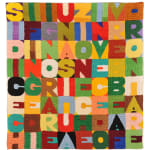
Alighiero Boetti Italian, 1940-1994
Si Dice chi Finge di Ignorare una Situazione che Invece Dovrebbe Affrontare, 1988
Embroidery
34.5 x 32 cm. (13 5/8 x 12 5/8 in.)
Copyright The Artist
